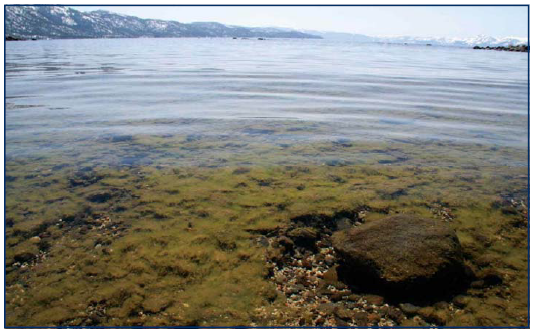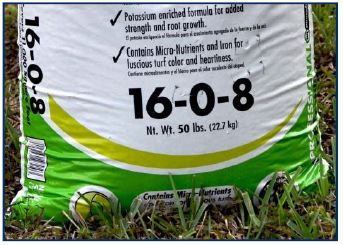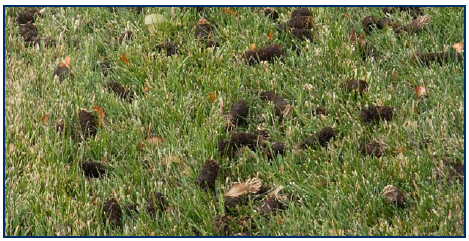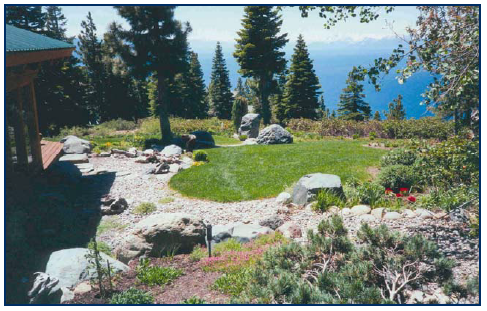If you have turf on your property and want to protect Lake Tahoe’s water quality, one of the most important things you can do is avoid over‐fertilizing your lawn. It’s vitally important to prevent plant fertilizers from washing off lawns or infiltrating to groundwater. When fertilizers enter the lake, they become food for unsightly algae, which fouls nearshore rocks and reduces water clarity (Figure 1).
Apply fertilizer to lawns only in spring and late summer
Residents and businesses are urged to apply fertilizers to turf only in spring and late summer. Property owners who hire lawn‐maintenance firms should direct the foreman to fertilize using the recommendations outlined below.
Pay attention to the timing of your fertilizer application. In the spring, apply lawn fertilizer only after the snowpack has melted. On shady high‐elevation or north‐facing sites, aim for a June application in most years. On warmer south‐facing sites, or after a warm spring, fertilize in late April or May. Apply fertilizer again after the last mowing in late August in higher, cooler locations or during the first half of September in warmer sites near lake level. This late summer application should be done when the average daily temperature for three or more consecutive days is below 50 degrees Fahrenheit. This promotes a vigorous, healthy root system and a hardy crown without encouraging shoot growth. Determine the average daily temperature by adding the day’s high and low temperatures and dividing the result by two.

Figure 1. This is algae growth in Lake Tahoe’s nearshore. Overuse of lawn fertilizers or excess irrigation after their application can stimulate algae growth in the lake. See TahoeBMP.org for more information.
Use the correct type of fertilizer
The Tahoe Regional Planning Agency (TRPA) recommends the use of phosphorus‐free fertilizer except when establishing new turf from seed. Tahoe soils have adequate phosphorus for turf for many years. The label on a fertilizer bag shows the percentage of the primary plant nutrients as a string of three numbers. The first number is percent by weight of nitrogen (N). The second number is percent by weight of phosphorus (P) as available phosphate (P2O5), and the third number is percent by weight of potassium (K) as soluble potash (K2O). Look for a fertilizer in which the middle number is 0.

Figure 2. This fertilizer label shows zero phosphorus.
It is possible that after several years of fertilization with no phosphorus, the soil could become deficient. If turfgrass blades turn purple, reddish‐brown or dark green, and show slowed growth, the soil may be deficient in phosphorus. A fertilizer with a phosphorus content of less than 5 percent may be applied in this case.
Calculating how much fertilizer to use
To determine the correct amount of fertilizer for each application, first calculate the area of your lawn in square feet by multiplying the length by the width. If your lawn is irregularly shaped, divide the turf area up into sections that approximate a square, rectangle or triangle; then calculate the individual areas and add them up. The area of a triangle equals one‐half the base times the height.
When fertilizing your lawn, apply only ½ to ¾ of a pound of actual nitrogen for every 1,000 square feet of lawn. The net weight of the fertilizer bag shown in Figure 2 is 50 pounds, but only 16 percent of that (0.16 × 50 = 8 pounds) is actual nitrogen. This means it takes 6 ¼ pounds of the product (50 ÷ 8 = 6.25) to get 1 pound of actual nitrogen. A lawn that measures 40 feet by 25 feet has an area of 1,000 square feet. Each application requires ½ to ¾ pound of actual nitrogen per 1,000 square feet. Since 6 ¼ pounds of the product contains one pound of nitrogen, apply about 3 to 4 ½ pounds of this fertilizer only twice per year for this lawn. Be careful of generic bag recommendations, such as “This bag will cover 3,000 square feet.” Use the rates and calculations recommended above for best results.
To use even less fertilizer, leave grass clippings on the lawn area to decompose and recycle nutrients back into the soil. Clippings should not be blown or raked into street guers or onto sidewalks and driveways, where they may be carried with runoff water to a storm drain and then into Lake Tahoe. If you recycle lawn clippings back into the lawn, use only ½ pound actual nitrogen per 1,000 square feet of lawn for your spring fertilization. Decomposing grass clippings are a good source of nitrogen.
A word about slow vs. fast‐release fertilizers
The goal of lawn fertilization is to stimulate root growth, which is essential for controlling erosion and reducing weed growth. Using the fertilizer application rates and schedule recommended above allows turf roots to take up nutrients rapidly in late spring and again in late summer or early fall, putting them to work strengthening and deepening root systems. Because they encourage rapid uptake of nutrients, conventional fast‐release fertilizers are acceptable. In fact, fast‐release fertilizers are especially important for the late summer or early fall application. Fall application of fast release fertilizer encourages rapid uptake of nitrogen just before the grass begins to go dormant. This nitrogen is stored in turf roots over the winter and results in rapid greenup of the turf in spring. Slow‐release fertilizer pellets applied in the fall may remain intact on the turf for months, making them vulnerable to washing off slopes and into waterways during rain showers. This could be harmful to the lake. On the other hand, slow‐release fertilizers applied in spring will release nutrients to the lawn slowly throughout the summer. Homeowners should refrain from applying extra fertilizer in the hopes of quicker results.
Follow up with good irrigation
Follow up any application of fertilizer immediately with adequate irrigation. Apply enough water to soak the ground 6 to 8 inches deep. This washes the fertilizer off the blades and into the root zone of the grass where it is quickly taken up into the plant. Do not over irrigate. This will leach (flush) the fertilizer down past the root zone and contaminate groundwater.
To ensure proper irrigation, it is important to check your lawn irrigation system annually for leaks and clogged spray heads. You can get a lawn water audit to determine if your system is working efficiently. Some public utility districts offer free audits. You can also hire a professional, or do it yourself.
“On‐off” cycle irrigation two or three times following a fertilizer application prevents the fertilizer from being carried away in surface runoff. Watering on a schedule of 10 to 15 minutes on, and one to two hours off, works well in many soils. Regulate the time “on” by watching for ponding or runoff. When ponding is noticed, shut the water off, note how long the water was on and then begin the “off” pattern of the cycle. Repeat the same time “on” again later and continue this pattern until the total irrigation time has been completed.
Compacted or very dry soils may require less time “on” and longer time “off.” Test the depth of wetness by inserting an 8‐ to 10‐inch screwdriver into the soil. When it penetrates easily 6 to 8 inches, enough water has been applied. Inexpensive moisture probes are also available at many nurseries. You can improve your lawn’s ability to absorb water by core‐aerating once or twice each year (Figure 3).

Figure 3. Hollow‐tine core aeration improves nutrient and water infiltration to the lawn and can prevent or alleviate the development of thatch. Leave the turf plugs on the lawn, where they break down and infiltrate back into the soil. Photo credit: Wendy Hanson Mazet.
A word about turf lawns at Lake Tahoe
Large lawns covering most of a property are not recommended at Lake Tahoe. Instead, property owners are encouraged to design small practical turf areas that are appropriate for the Lake Tahoe Basin. Such areas could be a small accent point near a home’s entrance or an extension of open space next to a deck. Practical turf areas can provide space for recreation or a play area for children. They also provide valuable defensible space from wildfire if located within 30 feet of the home (Figure 4). The important thing is to be very careful to maintain the turf properly, according to the instructions in this fact sheet and in University of Nevada Cooperative Extension’s Fact Sheet 13‐38, Water-Efficient Lawn Irrigation for Properties at Lake Tahoe. If you have more than 1 acre of turf on your property, TRPA requires that you prepare a Fertilizer Management Plan (Tahoe Regional Planning Agency BMP Handbook, 2012).
Protect Tahoe’s water quality
Follow the suggestions below to protect Tahoe’s water quality. Avoid applying any fertilizers in or near stream channels, wetlands or shore‐zone areas. If fertilizer is released onto a hard surface, such as a sidewalk or driveway, clean it up promptly. Never apply fertilizers over snow. Be extra careful when using fast‐release fertilizers, and do not over fertilize. Be aware that a rainstorm could wash fresh fertilizer into a direct drainage path to the lake. Before applying fertilizer, check the weather forecast to make sure no storms are predicted for two to three days after your application. Your goal is to ensure that fertilizer does not escape your lawn with rain runoff and flow to storm drains and eventually into Lake Tahoe. You’ll enjoy a healthy green lawn without affecting Tahoe’s clear water by following the recommendations in this publication.

Figure 4. This practical turf area provides defensible space, room for entertaining, and a play area for children.
For more information
Cobourn, John, et. al., (2006). Home Landscaping Guide for Lake Tahoe and Vicinity
Cobourn, J. and Kratsch, H. (2013). Water‐Efficient Lawn Irrigation for Properties at Lake Tahoe. University of Nevada Cooperative Extension Fact Sheet‐13‐38.
Tahoe Regional Planning Agency (2012). Fertilizer Management. Chapter 60.1.8 of the TRPA Code of Ordinances
Tahoe Regional Planning Agency (2012). TRPA BMP Handbook.
Washoe County/Reno: 775‐784‐4848
Douglas County: 775‐782.9960
Carson City/Storey County: 775‐887.2252
Cobourn, J. and Kratsch, H.
2013,
Use Fertilizers Sparingly on Lawns at Lake Tahoe,
Extension | University of Nevada, Reno, FS-13-37


